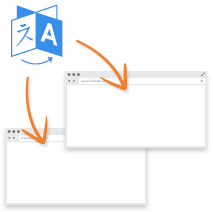So, why would a business owner want multiple home pages for a website?
 Consider this during the website content planning stage of your project. Designing and using multiple Internet home pages is not something all business owners may have thought about, until now. In fact, if you are realizing substantial website traffic and increased sales, adding an additional home page could change your current web statistics for the worse. On the other hand, if you are doing business internationally, you require localization for specific countries or regions, or you have unique intentions for different customer audiences, multiple home pages done correctly may be an option to consider.
Consider this during the website content planning stage of your project. Designing and using multiple Internet home pages is not something all business owners may have thought about, until now. In fact, if you are realizing substantial website traffic and increased sales, adding an additional home page could change your current web statistics for the worse. On the other hand, if you are doing business internationally, you require localization for specific countries or regions, or you have unique intentions for different customer audiences, multiple home pages done correctly may be an option to consider.Benefits in designing multiple home pages…
There are benefits in relying on multiple home pages when you have a multi-site business or require localization for different audiences. Multiple home pages gives you the flexibility to target a unique audience and speak directly to them in a language, format, or visually appealing manner you know they recognize and appreciate. When you have targeted your customers based on specific demographics, this technique is especially effective. You are able to:
- Get in the minds of customers based on what you already know about them
- Display the content in multiple languages
- Reach customers based on culture, age, careers, work scenarios, locations, and more
- Directly market to specific audiences through social media
- Increase website traffic with carefully planned marketing and search engine optimization without presenting a conflict for your customers
How multiple home pages can hurt your business…
When there is no real reason for to have multiple home pages, don’t do it. There are some downsides in using multiple home pages to attract customers:
- Time, effort, and cost involved in designing and maintaining them
- Duplicate content may be confusing to both your customers and search engines
- Search engines typically see duplicate content as a negative, causing you to rank lower in customers’ search results
- Search engine optimization becomes a challenge when you use the same keywords across multiple home pages
- Customers may be frustrated by multiple home pages unless you carefully plan your marketing strategy
Think visually. Improve UX with Slickplan
Build intuitive user flows, stronger customer journeys and improve information architecture.
What are the alternatives to multiple home pages?
If you are thinking about the benefits of multiple home pages, consider these alternatives to enhance your website traffic and help you gain leads and clients:
- Offer a viewable sitemap on your home page that directs customers to alternate pages
- Create a hub page with links, dropdown menus, and browser setting options to direct your website traffic
- Use a “store locator” link to share locations and contact information for various stores
- Include textual or visual content that links to a number of locations—useful for customers and search engines
- If you have a franchise, create a separate web page for each location including specific contact information, and make sure your sitemap includes them
- Consider a Facebook page or other social media platform to target specific customer audiences





 X
X

